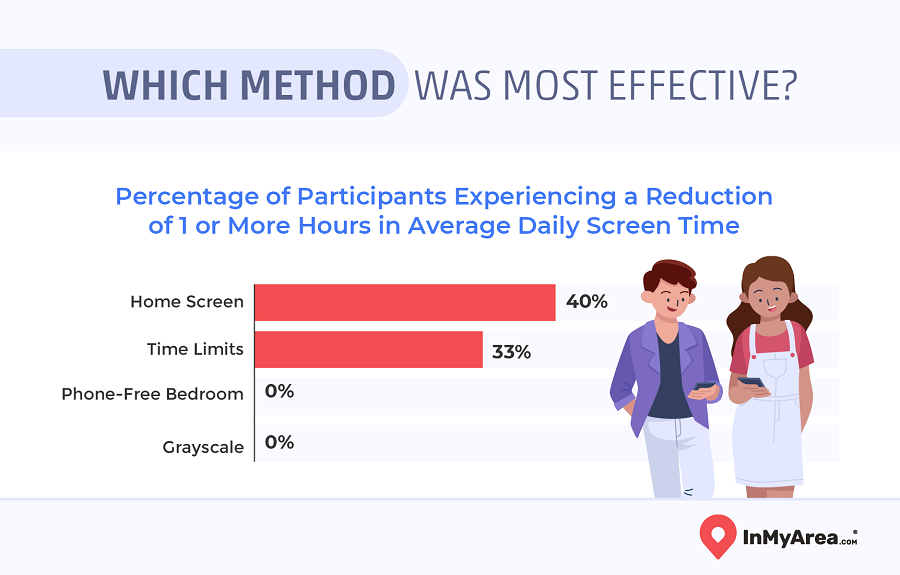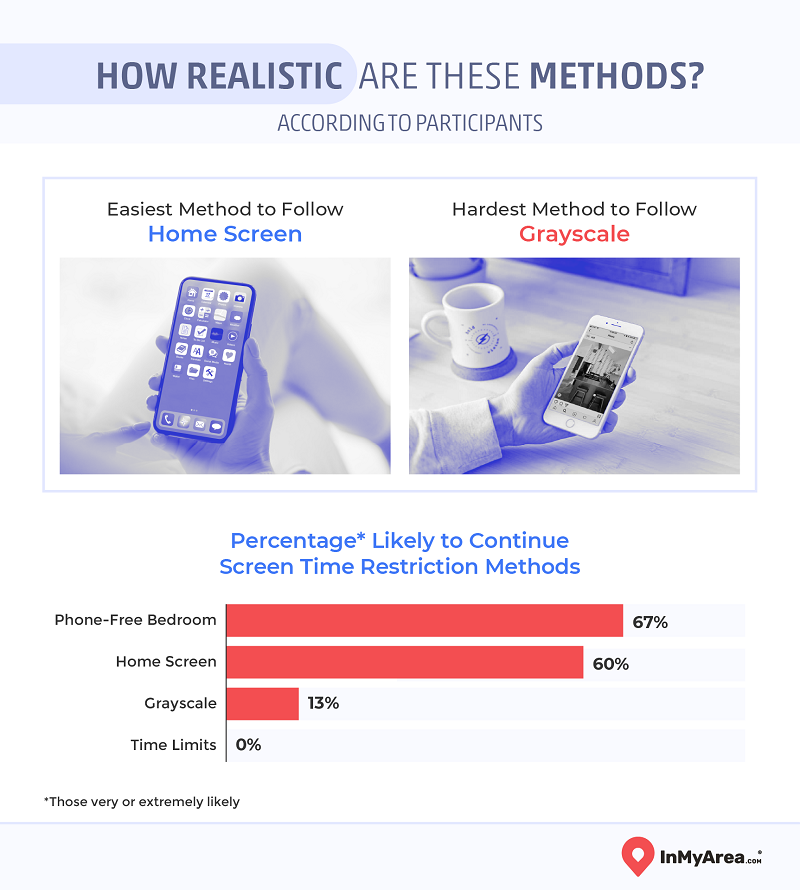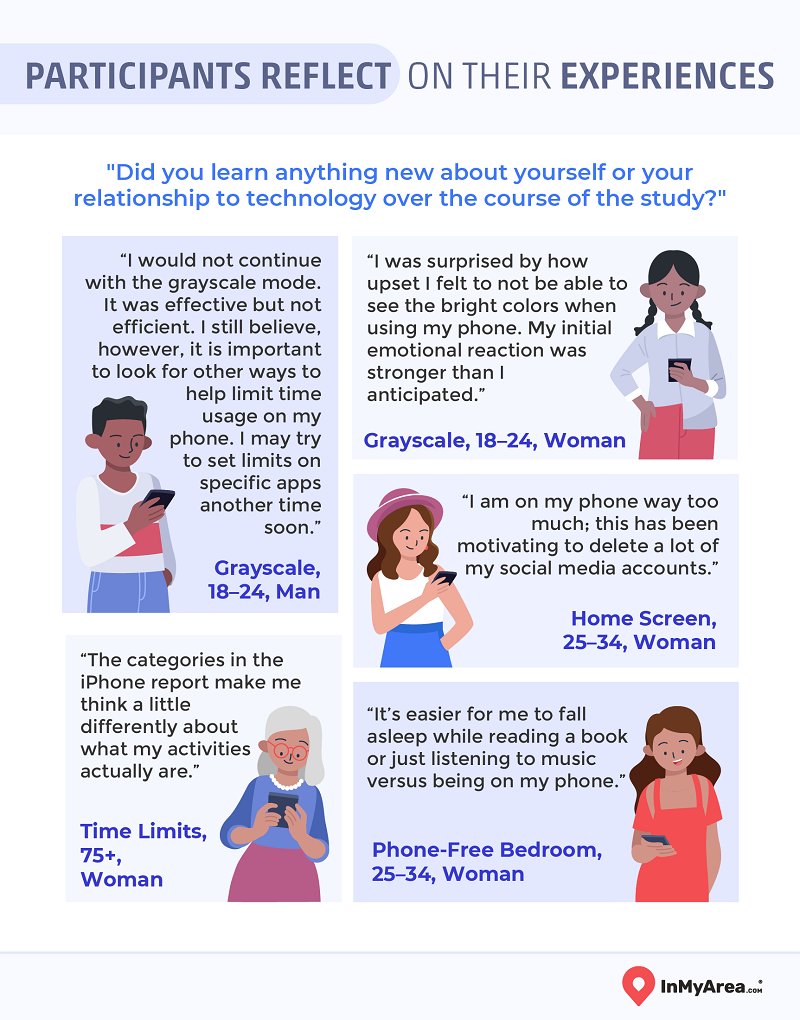Americans are addicted to their smartphones, and our usage reflects just how hooked we really are. Nearly one-third of Americans say they’re online almost constantly, and life on the internet affects our relationships, our work, our hobbies, and even where we get our news.
For people who want to take control of their phone’s role in their day-to-day life, it can be helpful to know where to start, and which strategies are most effective. To help, we conducted four experiments to see which reduced screen time and phone addiction. Which worked the best?
Key Findings
- If you’re an iPhone user looking to cut down on screen time, try removing the apps from your home screen and accessing them through the app library instead. This method was the most effective at reducing overall phone use, and it was also the easiest to maintain.
- Color psychology is a powerful way that phone designers and app developers capture our attention, and that played out in the study: Leaving the phone in grayscale mode was the most challenging method for participants to stick with, and it caused the largest negative impact on overall mood of any method.
Our Study, Explained
Ultimately, our goal in running this experiment was to study the relative effectiveness of several different strategies for mitigating phone use. We identified four methods with the potential to help participants reduce their overall smartphone usage, and you’ll see them referred to throughout this article as follows:
Phone-Free Bedroom
The first method was the phone-free bedroom, in which respondents left their phones in another room overnight. There are benefits of a technology-free bedroom – for example, the sounds and blinking of a phone can interrupt your sleep. Having your device outside of your room will increase the likelihood of you sleeping through the night and negate the temptation of checking it if you do wake up before your alarm goes off. For the study, most people used a physical alarm clock or another device to wake them up in lieu of their phone.
Grayscale
The next method was to activate grayscale mode on their phones, which removed all color from the display. The psychology behind this change is that by dulling your device, you will be less enticed to use it, and the tightly engineered attention-grabbing colors of notification badges and app icons would be less eye-catching.
Home Screen
Another strategy used was to eliminate all apps, except for the basic ones, from one’s home screen. They could still be accessed through the app library, notifications, and other methods, but the intent was to instill a soft barrier between users and the more addictive apps on their phones by removing easy access.
Time Limits
Lastly, users activated the time limit feature on their iPhone, limiting the usage of apps under the categories of Social, Games, and Entertainment to one hour per day. It’s important to note that the iPhone’s time limit feature allows you to “snooze” or even ignore the limit, so we were interested to see if participants’ wills would be strong enough to overcome the temptation to sneak a few more 15-minute increments in.
Respondents were asked to stick to their chosen method for a week, after which they submitted their respective screen time data and filled out a short questionnaire about their experience. The results were clear: Our participants found one method much easier than the others.
The Best Way to Go About Slashing Screen Time
When researching how to break or form new habits, it’s important to consider the psychological cost of these strategies and compare them to the observed, quantitative results. In our findings, there were some interesting disparities between participants’ perceptions of the effectiveness of certain methods and the realities.
Perceptions
As part of the exit survey for this study, we asked participants how effective they felt their method was at actually reducing the amount of time spent on their phone. Tallying the percentage of people who felt their method was very effective or extremely effective, the methods are ranked as follows:
- Phone-Free Bedroom
- Home Screen
- Grayscale
- Time Limits
One-third of participants using the phone-free bedroom method felt it was significantly effective, elevating it to the top of the list. In contrast, no participant in the time limits category felt that their method fit such a description.
Reality
In reality, though, it was the home screen method that shaved off the most time from respondents’ phone usage. Forty percent of participants in the home screen category saw their screen time dip by at least one hour per day, on average, during the experiment, compared to 33% of those using time limits and no one from the phone-free bedroom and grayscale categories.

Seeing as much of our scrolling is the unconscious behavior of shifting from one app to the next, removing addictive apps from your home screen will force you to specifically seek them out, naturally lessening your time on them. Despite the lack of perceived effectiveness, time limits also turned out to be moderately effective in reducing usage – an alternative method could be to set alarms on your phone at a desired increment that allow you to periodically check your phone quickly before resetting it. Also, even though respondents felt that a phone-free bedroom and grayscale made some difference in their usage, it in fact made a very small impact or none at all.
Sticking With It
Out of all four methods, people struggled the most with the grayscale mode – half of these participants said it was “very” or “extremely” difficult to use it for the whole week. What’s more, over half of respondents that opted for this method reported that their overall mood had declined noticeably throughout the seven days, compared to only about 10% of people in the other three categories combined.

Meanwhile, people using the home screen method had the least amount of trouble sticking to it – a large majority of them said they were either “very” or “extremely” likely to keep up with this strategy even after the experiment was over. Considering the home screen method yielded the most positive quantitative effects, this is an uplifting sign. Also, it was estimated that in 2019, kids in the U.S. exceeded 4 trillion minutes of screen time – parents should capitalize on the success of this method and try to get their children to follow suit!
Furthermore, a third of respondents said they’d give the phone-free bedroom strategy a go after the experiment, whereas only a small handful of grayscale respondents were interested in doing so, and no one using the time limit method was keen on sticking with it.
Reflections
Setting realistic goals is an important step in making new habits or breaking old ones. Whether you’re starting a diet, a new exercise routine, or trying to reduce your smartphone usage, keeping your goals achievable is crucial. In our study, one man who tried the grayscale method had the right idea: While participating in the grayscale mode trial, he did not particularly enjoy his experience nor find his method effective. However, he still wanted to find a way to cut down on his screen time for the long haul.

While our surveyee contemplated setting limits on some of his apps as an alternative to grayscale mode, there are many other ways to break bad phone habits, too. A lot of them involve downloading apps, which may sound counterintuitive, but they can help manage your usage – for example, Space, Forest, Moment, Flipd, and Screentime allow users to track and manage their habits, practice healthy usage, and increase focus in other, more important areas of their life.
Conclusion
Out of the four methods examined in our study, people felt that leaving their phone outside of the bedroom when retiring for the night was the most effective in reducing their screen time. While those surveyees thought that was the case, removing addictive apps from one’s home screen was actually the strategy that showed the most promising results.
People who cleaned up their home screens were also the most likely to stick with this strategy after the experiment concluded, while the majority of those who tried grayscale mode found the experience unhelpful and draining.
For readers interested in altering their own phone use habits, our data supports giving the home screen method a trial run. However big or small a change may be, putting our phones down and quite literally stopping to smell the roses is a step in the right direction!
Our Data
Participants in this study ranged in age from 18 to over 75, with 50% between the ages of 18 and 24, 42% between 25 and 34, 4% between 35 to 44, and 4% were 75 years or older. Gender was roughly evenly divided between women and men, with a small number of nonbinary participants. There were 26 participants in total, divided between the four screen time control methods. Data was collected through the user’s iPhone Screen Time feature, a built-in feature on devices running iOS 13.3 or later that provides a variety of tools to track and manage usage of Apple devices. Participants were all iPhone users with devices of generation 6 or newer. The study duration was seven days for each participant.
Because of the intensive nature of this study, our sample size was relatively small. Further research into the efficacy of these methods would likely turn up interesting results in conversation with our study, and we encourage other researchers to study these techniques as well.

